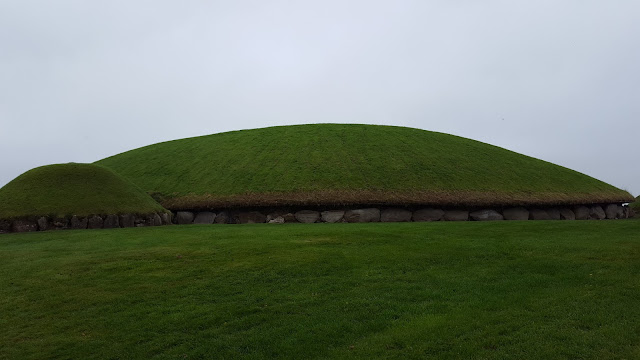HIST & MYTH: Knowth - An Ancient Site
Written by Ben Kesp
Referred to as the Jewel of Europe’s Neolithic Period, the Boyne Valley or in Irish, Brú no Bóinne, Co. Meath, is the largest Megalithic site in Europe, dating back over five thousand years. The complex of the Boyne Valley has numerous ancient monuments and archaeological features but the jewels or often called the Cathedrals of the Neolithic period are the great monuments (tombs/temples) of Newgrange, Knowth and Dowth, with the three forming a triangular formation on the landscape.
 |
| Knowth Mound |
On arriving at Knowth, a sense of peace and reverence awaits you, unlike the more famous Newgrange monument which exudes its own but different presence. Knowth is peaceful as if the monument and the past it hides are slumbering, keeping its secrets buried and safe. Surrounding the great mound at Knowth are eighteen smaller mounds similar in nature. The massive mound contains two passages ending at two internal chambers. The western passage is 34 metres and the eastern passage is 40 metres, making it the longest in Europe.
Much is yet to be understood about Knowth. The monument is highly decorated with Megalithic art and Knowth’s art work features different crescent shapes from that of the other two major sites in the Boyne Valley and contains over one-third of all Western Europe’s Megalithic art work.
Lunar Map
Knowth has many interesting features including a carving believed to represent the map of the moon, ten times older than the map drawn by Leonardo da Vinci in 1505 and was found by Dr. Philip Stooke of the University of Western Ontario, Canada during his investigations at Knowth.
Calendar Stone & Lunar Stone
The Calendar Stone shows the cycle of the moon and the Lunar Stone calculates the length of the lunar year, tropical and synodic months - journey of the moon cycle which is longer than Earth’s orbit around the sun.
Equinox alignment
Even though it was believed the passages aligned with sunrise/sunset, new theories are now in debate about the alignment of the passages within Knowth.
 |
| Knowth: One of the Internal Passages |
The site at Knowth was used before the Neolithic building of the great monument and use of the site continued well after the Neolithic age. During the Iron Age, the top of the mound housed a settlement and souterrains added which are still visible today. During the Norman invasion of Ireland, the Normans used Knowth as a motte and bailey. Following this, the site fell into the hands of the Cistercian monks and the land around it became used for farming. In 1939 it came under the care of the Irish state and was awarded a UNESCO World Heritage site in 1993.
All sites on the Boyne Valley are magnificent experience to visit however Knowth does not receive the attention it deserves often overshadowed by Newgrange. A place of wonderment, archaeology and soulful energy awaits you in this magnificent ancient construction of Knowth.
 |
| Knowth - Front Entrance |


Comments
Post a Comment